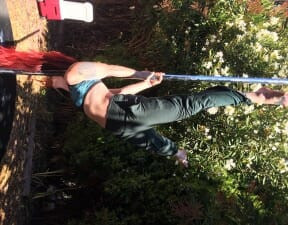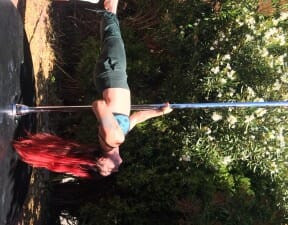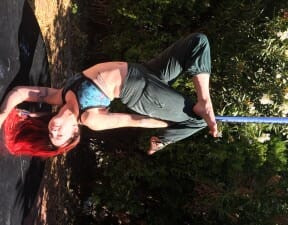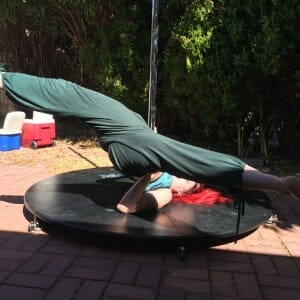When many envision pole dancing, images of minimal attire often come to mind. However, the reality of pole dance is far more versatile and inclusive. For those new to the practice or seeking alternatives, exploring pole dance with clothes on – or “Clothes Pole Dance” – opens up a world of benefits and creative expression. Initially, like many, I equated pole dancing with skimpy outfits, arriving at my first classes in typical pole shorts and a tank top. Now, my studio arrival is quite different. I make it a point to wear pants, with shorts underneath, and keep them on for as long as possible. Let’s delve into why embracing clothes for pole dance, or “clothes pole dance,” can be a game-changer and how to tailor your routines for a covered-leg aesthetic.
One of the most immediate advantages of “clothes pole dance” is warmth and comfort. Stepping into a chilly studio, especially during colder months, can be uninviting. The cold pole and floor can tighten muscles, making it less than ideal to strip down immediately. My personal experience with outdoor performances solidified the importance of warmth. Once, promised a heater for an outdoor winter show, I arrived to find none. Shivering through my performance highlighted the need for routines adaptable to colder conditions and more clothing. This led me to develop choreography specifically designed for pants, which I now share with my students during winter to ensure everyone’s comfort and warmth. This approach is central to the concept of “clothes pole dance” – making the art form accessible and comfortable in diverse environments.
Beyond personal comfort, “clothes pole dance” addresses broader perceptions and accessibility. Concerns about the perceived lack of “kid-friendly” or “family-appropriate” nature of pole dance often arise due to the stereotypical image of revealing costumes. While such criticisms can be frustrating, especially when considering the often more revealing attire seen in everyday beach culture, offering the option of “clothes pole dance” can be incredibly helpful in broadening the appeal and acceptance of pole dance. It allows potential clients and audiences to see past the attire and appreciate the athleticism and artistry.
 Iguana Grip
Iguana Grip
Photo 1: Pole dancer demonstrating an Iguana Grip pose, showcasing strength and control in clothes pole dance.
Furthermore, many beginners feel more comfortable starting their pole journey in leggings or pants. The idea of immediately transitioning to minimal clothing can be daunting for new students. I’ve witnessed firsthand the relief students express when I reassure them that they don’t need to wear revealing outfits right away. This is particularly relevant for those first-timers who may not yet grasp the concept of skin grip on the pole and arrive in yoga pants. “Clothes pole dance” provides a welcoming and less intimidating entry point into the world of pole fitness.
Finally, “clothes pole dance” champions creative freedom and costume versatility. Sometimes, choreographers, directors, or photographers have specific costume requests that might involve more coverage. Having the skills and routines adaptable to various clothing styles expands a dancer’s versatility and professional opportunities. Being proficient in “clothes pole dance” allows you to meet diverse creative demands and embody a wider range of characters and performance styles.
Now, let’s explore the practicalities of “clothes pole dance” techniques. Assuming you’re not opting for super-sticky pleather pants (which present their own unique challenges), certain adjustments are necessary. Knee grips and thigh holds in the air become less reliable, though knee grips at very low levels can still work with floor contact. However, a vast range of grips remain fully accessible in “clothes pole dance”: hand grips, elbow grips, lever grips, armpit grips, shoulder mounts, and foot grips (think starfish variations). It’s crucial to ensure you’re confident in executing tricks without pants before attempting them with clothes, unless your focus is purely on slide-based floorwork. Remember, performing tricks with less skin contact will generally require more strength and endurance.
 Photo 2: Table Top
Photo 2: Table Top
Photo 2: Table Top pose in clothes pole dance, highlighting upper body strength and balance.
Strength-based moves truly shine in “clothes pole dance.” Iron X’s, iguana grip variations, planches, tabletop holds, air-walks, and handstands are all excellent choices (as seen in Photo 1: Iguana Grip; Photo 2: Tabletop; and Photo 3: Forearm Stand Variation). The key adaptation for “clothes pole dance” with strength moves is often in the entry and exit. You’ll likely need to initiate these tricks from the ground and ensure a safe return. For example, achieving an ayesha may require entering from a handspring or deadlift rather than an inside leg hang. While a basic climb might be possible in pants (though significantly more challenging and requiring caution!), “clothes pole dance” is a perfect opportunity to refine your hand-over-hand climbing technique. Be mindful that resting on the pole above ground will be limited. Armpit grip poses like a teddy can offer a brief respite, but always conserve energy for a controlled dismount in “clothes pole dance”.
Pole tumbling tricks translate seamlessly to “clothes pole dance.” Back tucks, walk-overs, and shoulder mount flips remain largely unchanged when starting from the ground. Experiment with walk-over variations from a yogi handstand in “clothes pole dance.” Maintain a strong grip with your inside hand and allow a generous back arch. Your grounded hand will need slight adjustments – keep it relaxed. For back-walkovers in “clothes pole dance,” emphasize a powerful push from your shoulders.
 Photo 3: Forearm Stand Variation
Photo 3: Forearm Stand Variation
Photo 3: Forearm Stand Variation in clothes pole dance, illustrating balance and control with covered legs.
Floorwork is a natural ally of “clothes pole dance.” Pants offer knee protection and facilitate smooth gliding across the floor. “Pole skating” classes specifically designed for floorwork in pants are gaining popularity. Favorite floorwork tricks in “clothes pole dance” include toe fans, shoulder rolls and stands (Photo 4: Shoulder Stand Split), chest stands (for a more advanced entry, try a yogi handstand into a controlled chest/chin lowering), and back splits on the pole.
Spins are also viable in “clothes pole dance.” Static spins often prove more effective when wearing pants, particularly those involving leg contact with the pole. Roundabouts and juliet spins are especially enjoyable and well-suited for “clothes pole dance.”
While pleather pants offer extreme stickiness, they limit sliding and static spins, making them better suited for spin pole routines within “clothes pole dance.”
Finally, remember the importance of flexibility training, a crucial component of any pole practice, including “clothes pole dance.” Pants are actually beneficial for flexibility work. Unless you possess naturally deep splits, pants and socks aid in sliding into your maximum split position on the floor. If your bare skin sticks to the floor, you inadvertently engage muscles you’re trying to stretch, hindering progress. This is why I consistently advise my students to wear pants over shorts during flexibility sessions, optimizing their stretching potential in “clothes pole dance” and general pole training.
 Photo 4:
Photo 4:
Photo 4: Shoulder Stand Split, also known as Floor Jade, performed in pants, showcasing flexibility in clothes pole dance.
Embrace the versatility of “clothes pole dance.” It’s a fantastic way to stay warm, expand accessibility, explore creative costuming, and adapt your technique. Share your photos and videos of your “clothes pole dance” training sessions and inspire others to explore this liberating and inclusive approach to pole!
By Jody Ryker
www.polediversity.com
